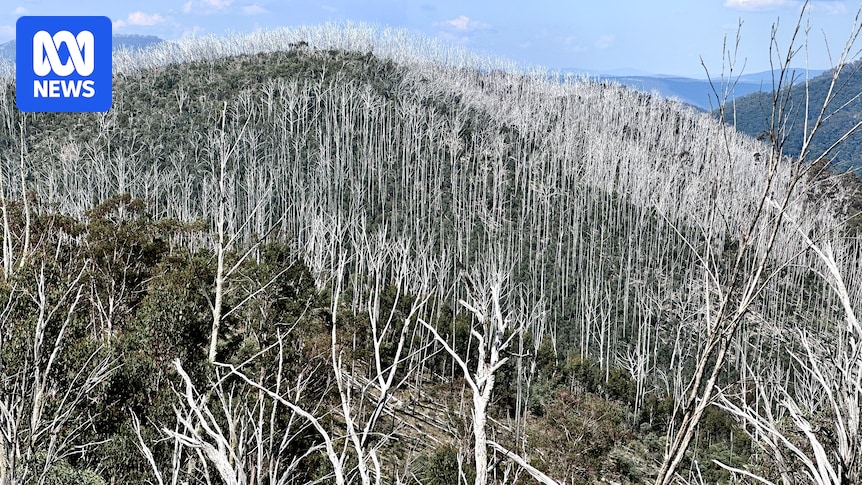Vast tracts of Victoria’s alpine forests are one major bushfire away from oblivion, according to a growing number of scientists.
Alpine ash, a tall eucalypt, is most vulnerable to fire because it takes at least 20 years to produce seed.
“There’s probably about 80,000 hectares which is young forest currently and will be young forest for the next decade or so,” University of Melbourne scientist Tom Fairman said.
“If we can’t reforest these areas after the big repeat bushfire events, we’re not going to have that habitat resource in the future.”
Dr Fairman, a future fire risk analyst at the School of Agriculture, Food and Ecosystem Sciences, has calculated that in the past two decades, half of the state’s mountain forests have been ravaged by bushfire.
Tom Fairman says about half of Victoria’s alpine ash range has been burnt in just 20 years. (ABC Landline: Tim Lee)
After six high-intensity major fires in those years, government agencies have re-sown tens of thousands of hectares of burnt country, broadcasting seed from aircraft to reach impenetrable slopes and valleys.
With fires occurring on average every four years, young alpine ash that has not sprouted since then are at high risk of summer bushfires killing them all.
Dr Fairman called it a “ticking time bomb”.
Fire-prone forests running out of time
He and other leading scientists, alarmed at the precarious state of the mountain forests, have accused the Victorian government of not doing enough to address the problem.
Owen Bassett, a silviculture, or forest, scientist has spent decades working on the post-fire recovery of Victoria’s 600,000 hectares of alpine and mountain ash forests.
Forester Owen Bassett says eucalypt seed supplies are dangerously low. (ABC Landline: Tim Lee)
From a mountain near Mount Hotham he looks across ridges of dead trees rolling to the horizon.
Some are weather-bleached skeletons, others are strewn across the bare ground.
Devastating fires, not logging as some claim, are to blame.
The trees, which grow to 80 metres, once flourished here but this landscape is so degraded some want alpine and mountain ash declared a threatened species.
Mountain ash trees are some of tallest in the world. (ABC Landline: Tim Lee)
Successive fires have thwarted attempts to re-seed the trees.
Mr Bassett said the sudden shutdown of Victoria’s native timber industry in 2023, six years earlier than expected, had inadvertently further jeopardised this ecosystem.
Vic Forests, which was responsible for collecting and preserving vital eucalypt seed for forest regeneration, was closed.
“In their absence, DEECA [Department of Environment, Energy and Climate Action] is attempting to put together a seed program,” Mr Bassett said.
‘Woefully low’ action from government
The government has just awarded tenders to seed harvesting contractors who scale the giant trees to gather the tiny pinhead-sized seeds at the tree’s crown.
Landline can reveal the contracts are only for one to two tonnes of seed from alpine and mountain ash species in the next two years.
Mr Bassett describes the amount as “woefully low”. In past years about three times that amount was collected.
He believes 17 tonnes of seed is now needed to ensure there are sufficient supplies to re-seed burnt areas after severe bushfires.
Pinhead-sized alpine ash seeds grow into one of the largest plants on the planet. (ABC Landline: Tim Lee)
He said responsibility for the alpine forests should be broadened and favours the establishment of privately funded seed banks supported by corporate and community donors to assist the state.
“This forest type is iconic, really worthy of protecting and saving, so we want to do everything we can to help the government do that,”
Mr Bassett said.
Repeated devastating bushfires have destroyed vast tracts of alpine forest. (ABC Landline: Tim Lee)
Victoria’s native species seed bank was depleted following re-seeding efforts after the Black Summer bushfires.
Next to no seed has been collected since the timber industry shut down and seed-harvesting contractors were retrenched.
Brendon Clark, long regarded as the industry’s best harvester, did not put in a tender for the latest seed collection contract.
Former seed harvester Brendon Clark once scaled Victoria’s tallest trees to collect seed. (ABC Landline: Tim Lee)
He said the amount of seed and the remuneration were both inadequate.
“Our forest is in serious trouble,” Mr Clark said.
“It isn’t that the alarm bells are about to ring. They already have and if these last two fires are not enough to scare the pants off you, I don’t know what is.”
Watch ABC TV’s Landline at 12:30pm AEST on Sunday or stream any time on ABC iview.
